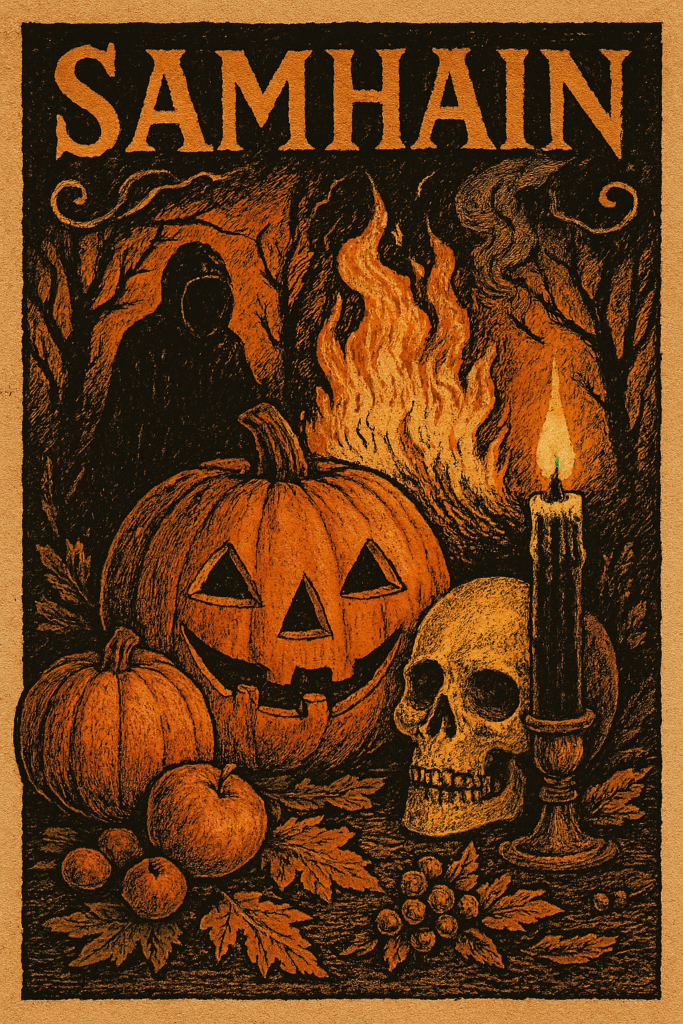
Samhain (pronounced SOW-in) marks one of the most significant festivals in the Pagan Wheel of the Year. Celebrated from sunset on October 31st to sunset on November 1st, it heralds the end of the harvest and the beginning of the dark half of the year. Rooted in ancient Celtic tradition, Samhain is a liminal time when the veil between the worlds is believed to thin, allowing spirits, ancestors, and otherworldly beings to cross into the mortal realm.
Historical Origin
s Samhain originates from the Gaelic peoples of Ireland, Scotland, and the Isle of Man. It was one of four major seasonal festivals—alongside Imbolc, Beltane, and Lughnasadh—marking the transition between light and dark, summer and winter.
- Agricultural Significance: Samhain coincided with the final harvest. Crops were gathered, livestock were culled, and communities prepared for the hardships of winter.
- Spiritual Beliefs: The Celts believed that during Samhain, the boundaries between the physical world and the spirit world dissolved. This allowed the dead to visit the living, and divination practices flourished.
- Christian Adaptation: With the spread of Christianity, Samhain was syncretised into All Saints’ Day (November 1st) and All Souls’ Day (November 2nd), though many of its folkloric elements persisted in folk customs and later evolved into Halloween.
Folklore and Mytholog
Samhain is steeped in mythic resonance. It is a time of storytelling, ancestral honouring, and supernatural caution.
- The Aos Sí: These fae or spirit beings were believed to roam freely during Samhain. Offerings of food and drink were left to appease them and avoid mischief.
- Ancestral Spirits: Families would set places at the table for departed loved ones, light candles in windows, and maintain silence during certain rituals to honour the dead.
- Divination: Samhain was ideal for scrying, apple bobbing, and other forms of prophecy. Young people might divine their future spouse or glimpse omens for the coming year.
Traditional Practices
Modern Pagan and Wiccan communities continue to celebrate Samhain with reverence and ritual.
- Bonfires: Originally lit to ward off evil spirits and honour the dead, bonfires remain central to Samhain gatherings.
- Dumb Suppers: Silent meals held in honour of ancestors, often with a place set for the deceased and food left untouched as an offering.
- Altar Building: Altars are adorned with seasonal items—pumpkins, apples, skull motifs, black candles, and photographs of ancestors.
- Rituals of Release: Practitioners may write down what they wish to let go of and burn the paper, symbolising death and renewal.
Modern Gifts and Offerings
Gift-giving during Samhain is less commercial than other festivals, but symbolic items are exchanged or offered to spirits and loved ones.
- Crystals: Obsidian, smoky quartz, and black tourmaline are popular for protection and grounding.
- Herbal Bundles: Mugwort, rosemary, and sage are used for cleansing and spirit work.
- Candles: Black for protection, orange for vitality, and white for ancestral connection.
- Seasonal Treats: Baked goods like soul cakes, spiced cider, and pumpkin bread are shared among friends or left as offerings.
- Handcrafted Talismans: Items imbued with intention—such as protective charms or ancestor tokens—are gifted to loved ones or placed on altars.
Conclusion
Samhain is not merely a precursor to Halloween—it is a profound spiritual observance rooted in death, remembrance, and transformation. As the wheel turns and the nights grow long, Samhain invites reflection, connection with the unseen, and honouring of those who came before. Whether through ritual, folklore, or quiet remembrance, it remains a sacred time for those who walk the Pagan path.
